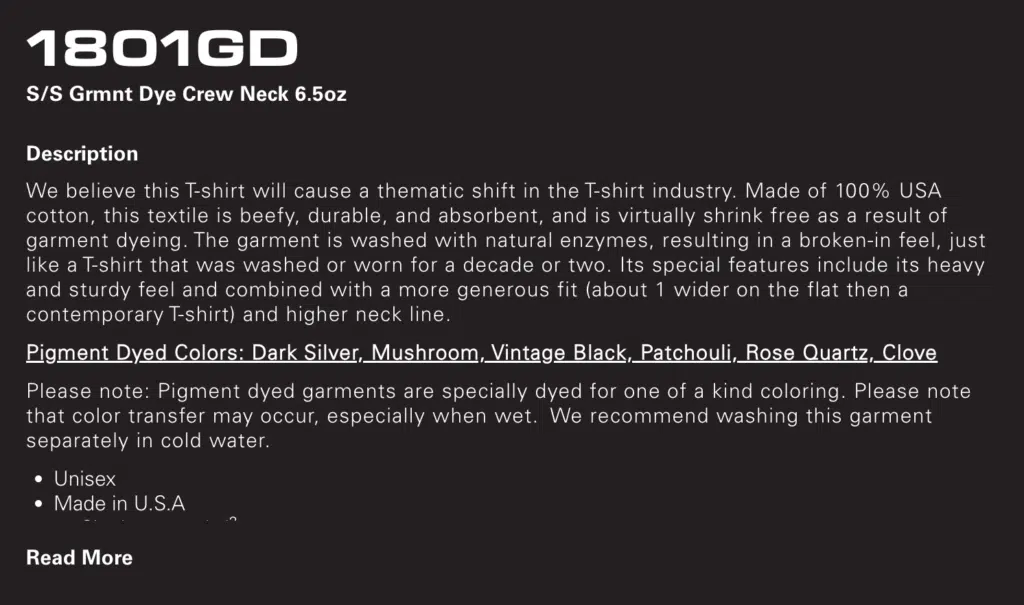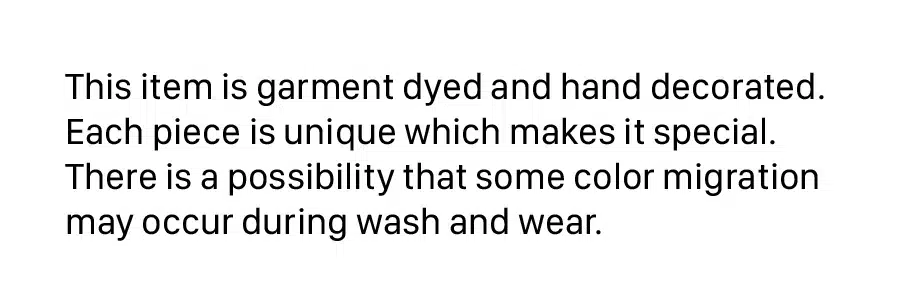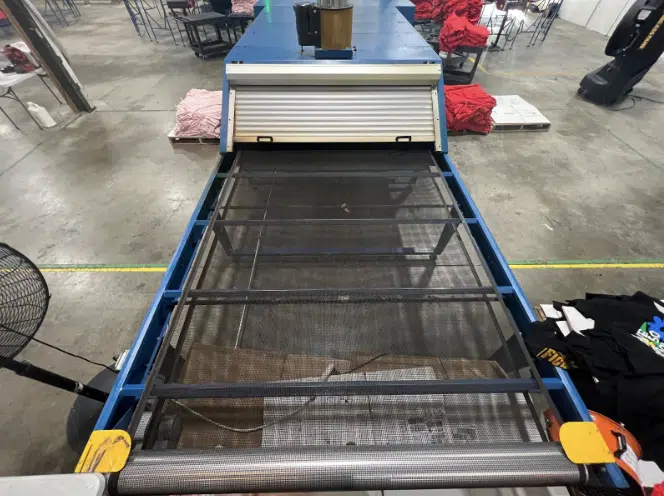Product Disclaimer
External Release Updated 8/8/2023
The ensuing disclaimer serves as a formal action plan designed to guarantee the maintenance of superior quality and adherence to industry standards concerning color variation in all of our products at Culture Studio. We unequivocally commit ourselves to the excellence of our product portfolio, implementing extensive measures to ascertain both fan and client satisfaction.
Our endeavor is to resonate with our client’s achievements, striving to be an unwavering partner. We shall undertake this mission by introducing the following key strategies:
Comprehensive Quality Control: Implement a rigorous quality control process to ensure that all products conform to the highest standards of quality and are free from any defects.
Color Consistency: Employ cutting-edge technologies and methods to maintain consistency in color across all of our product lines, aligning them with industry benchmarks.
Customer Satisfaction: Develop a robust feedback mechanism to understand and address the needs and expectations of our clients and fans, thereby fostering an enhanced user experience.
Reliable Partnership: Strengthen our client relations through effective communication, transparency, and commitment to shared goals, thus establishing ourselves as a reliable partner.
By embedding these strategies within our operational framework, we shall ensure a steadfast dedication to product superiority, customer contentment, and the fortification of our client relationships.
Print Variance
10% Color Tolerance: This discrepancy in color is a result of processing high volumes across different factories at varying times on multiple dye lots. While we maintain that these items fall within acceptable tolerance levels, we commit to implementing additional measures to minimize this variance.
Garment and Pigment Dye
- Garment-Dyed and Pigment-Dyed Garments
-
-
- The very nature of a garment or pigment-dyed garment is the uniqueness of each item. Garment dye creates a “vintage” effect and provides a unique look to each garment. When rushing this process, no matter who the mill was during that time period, the sourcing (cleaning of fibers) process may be rushed at certain points, resulting in the dye not fully binding to the fabric. When this happens, there is a possibility that after time (usually 24-48 hours) a reaction called “dye migration” may occur and the dye bleeds into the ink.
-
See verbiage on garment dye from mill below.
-
- Corrective Action – Quality Control on Dyed Garments
- When utilizing custom dyed garments, there is potential of over dying goods that is not isolated to an entire lot run but rather scattered throughout the bulk of production. This happens due to the nature of a garment or pigment-dyed garment – each item is unique. Garment dye creates a “vintage” effect and provide a unique look to each garment. When rushing this process, no matter who the mill was during that time period, the sourcing (cleaning of fibers) process may be rushed at certain points, resulting in the dye not fully binding to the fabric. When this happens, there is a possibility that after time (usually 24-48 hours) a reaction called “dye migration” may occur and the dye bleeds into the ink.
- Options for Printing on Garment Dyes
-
- Most garment dye blanks lean towards vintage or softer styles of print. Traditionally, water-based printing is the preferred method whilst taking into account the 10% garment variance, and the ability for possible defects from the garment dyeing process. This is not in every case, but may occur in certain batches.
- Utilizing a charcoal infused blocker base to absorb the dye gasses from passing through the screen print inks and shifting the colors of the decoration. This method is always utilized on any poly printing and is proven to be effective. This will add an extra layers of ink which results in a heavier hand feel and is the preferred method for Athletics printing.
- Dryer Set Up and Catching Techniques
-
- Dryer temps are set low to cure ink no greater than 300 degrees.
- Fans or cooling stations are placed at end of belt to allow cooling of garments before stacking
- Hot box test
- As bulk production begins, the first shirt that comes out of the oven is folded ( to retain its heat) and put into a closed box.
- This allows for the heat in the shirt to stay warm for as long as possible, pushing the migration process to start earlier than later.
- Box is to be checked every 2 hrs for any signs of dye migration.
- Box is to be labeled (test 1 – Time of test ) – this will be repeated every two hours as the print run continues.
- If at any point dye migration is observed, stop all production and test that batch of garments for further inconsistencies.
- Communicate with the buyer for approval of pieces that have shifted color.
- The Most Effective Strategy
- This issue is best prevented by incorporating a barrier base underneath the print. However, it is important to note that a barrier base significantly increases the texture of the print, which at times could diminish the desired “vintage appearance” to correspond with the garment.
Print Variance Sticker
This sticker may be placed on each garment dyed item to remove uncertainty to the end user.
Quality Control Assurance Process
The ensuing document serves as a formal action plan designed to guarantee the maintenance of superior quality and adherence to industry standards concerning color variation in all of our products at Culture Studio. We unequivocally commit ourselves to the excellence of our product portfolio, implementing extensive measures to ascertain both fan and client satisfaction.
Our endeavor is to resonate with our client’s achievements, striving to be an unwavering partner. We shall undertake this mission by introducing the following key strategies:
Comprehensive Quality Control: Implement a rigorous quality control process to ensure that all products conform to the highest standards of quality and are free from any defects.
Color Consistency: Employ cutting-edge technologies and methods to maintain consistency in color across all of our product lines, aligning them with industry benchmarks.
Customer Satisfaction: Develop a robust feedback mechanism to understand and address the needs and expectations of our clients and fans, thereby fostering an enhanced user experience.
Reliable Partnership: Strengthen our client relations through effective communication, transparency, and commitment to shared goals, thus establishing ourselves as a reliable partner.
By embedding these strategies within our operational framework, we shall ensure a steadfast dedication to product superiority, customer contentment, and the fortification of our client relationships.
The top section is the inspection process for Quality assurance. The remaining entries are part of the process to control quality throughout the manufacturing process.
Initial Production Print – This process illustrates the flow for the initiation of our production print.
Compare the initial production print with the pre-approved standard for verification.
The approved print is endorsed by the Press Lead, Press Assistant, and Quality Controller. High-resolution images of the approved print are archived in our platform for easy review and future replication.
Any potential Quality Control (QC) concerns are debated and emphasized for immediate attention.
- The first approved print(s) is marked and documented by QC as “First (specify size + date) Print TOPS”.Photo of labeled print to be taken and stored in the platform.
- Final print(s) of that same garment size is saved and labeled as “Final (specify size + date) Print TOPS”. Photo of labeled print to be taken and stored in the platform.
Repeat steps for each garment size on each production day.
The below action items are part of the daily process to prevent future deviation from any approved samples.
1. Intertek Third-Party Checks
Culture Studio has developed a relationship with Intertek and when requested will be requesting a 2.5AQL inspection be done on all production leaving the facility moving forward.
2. Sampling
This process is to maintain the integrity of sample documentation for future use.
- We will observe garment preferences and determine the best print process based on artist/management preferences.
- Options for sampling with soft hand base vs. barrier base.
- Generate risk analysis of color shifting based on turn time, manufacturer, and past experience.
- Additional samples are kept by CS and used as a standard for matching during production.
- High resolution, color-corrected photos of the samples going to executive management are documented in the platform for easy reference.
3. QC on Press
- An iPad containing high-resolution images of the approved print is provided to the press operator and assistant for reference. These images have been previously forwarded to the Executive Management for their review and endorsement. This serves as a critical resource to ensure adherence to the approved design throughout the production process.
4. Staging at the QC Belts
a. After approval of the initial production print (1.a), the standard is staged at the end of the belt for the Quality Controller to reference.
- One dedicated QC per design per location.
- Anything deviating from the standard will be immediately stopped and corrected.
- All goods deviating from the standard are to be separated for further inspection by the Creative Director and QC Supervisor.
- Utilize Colorimeter to gauge % change when applicable.
- Rejected pieces will be photographed and documented with causation.
b. Wash tests conducted on randomly selected pieces.
- (1) Wash test performed per production day, per design, per shift.
- Photos of wash tests stored in the system and labeled by date/shift.
-
Positions
Quality Control Lead
Quality Control Auditor
Quality Control Belt
QC Lead
- Performs root cause analysis on QC issues
- Updates D&D log alerting sales and BC’s of issues
- Training and Conformance to CS standards has been executed by Lead with team that is involved in the mistake
- Signed D&D log by all parties and stored in G-Drive for reference
- Spot checks in Print, Fulfillment, Tagging , Embroidery for Quality
- Continuous training and supervision of Process and Team Members for QC conformance
- Every order is Confirmed by QC LEAD prior to moving to another department
Finishing
- Check fold dimensions, size strip placement, correct hang tags (Retail and Artist), hologram, and box (CS, Retail or recycle box)
- Scan barcodes to make sure there is scannable and matching label info.
- Document, take photos and file them into Google Drive.
- Report any issues related to the finishing packaging.
QC Belt Responsibilities:
- Utilize a sample for reference with each task.
- Sort and place printed products into the designated cart/bin for the subsequent department.
- Halt production immediately upon identifying any issues such as print imperfections, misalignment, incorrect positioning, or stains on the garment/image.
- Segregate damaged products and forward them to the QC Manager for evaluation. The QC Manager will decide if any products can be salvaged (e.g., touched up, sprayed out).
- Complete necessary paperwork for every order.
- Ensure only products adhering to CS Quality Standards proceed to the next department.
- Update the Platform regarding any product shortages.
- Label all carts/bins with relevant job numbers.
- Prep garments for printing during press set up and takedown intervals.
Press Lead Responsibilities:
- Oversee team operations and address any issues related to screen printing by:
- Examining screens for appropriate size, lack of imperfections, and proper tape application.
- Setting up the press and conducting test prints to guarantee order readiness.
- Obtaining approval from the Production Manager to process the entire order.
- Post-approval, reassessing to ensure all screens are operational, color-accurate, and correctly placed.
Press Assistant Duties:
- Inspect the print before removing garments from the machine, confirming consistent quality as initially approved by the Production Manager. This involves checking:
- Registration and alignment.
- Print clarity and absence of imperfections.
- Correct color usage.
- Centralized and straight printing.
- Clean, non-dripping screens.
- Report any printing discrepancies to the Press Lead immediately.
- This streamlined version retains all the essential details while making the responsibilities more concise and structured.
c. Hot Box Test
-
- As bulk production begins, the first shirt that comes out of the oven is folded ( to retain its heat) and put into a closed box.
- This allows for the heat in the shirt to stay warm for as long as possible, pushing the migration process to start earlier than later.
- Box is to be checked every 2 hrs for any signs of dye migration.
- Box is to be labeled (test 1 – Time of test ) – this will be repeated every two hours as the print run continues.
- If at any point dye migration is observed, stop all production and test that batch of garments for further inconsistencies.
- Communicate with the buyer for approval of pieces that have shifted color.
d. The Most Effective Strategy
-
- This issue is best prevented by incorporating a barrier base underneath the print. However, it is important to note that a barrier base significantly increases the texture of the print, which at times could diminish the desired “vintage appearance” to correspond with the garment.
Surveillance System
In partnership with Verkada Systems, Culture Studio is undertaking the installation of a 4K camera on each conveyor dryer. This initiative will empower our technicians with the ability to retrieve and review footage from both production facilities. The high-resolution visuals will serve as verifiable evidence of our adherence to quality standards, providing transparent and undeniable proof of our commitment to excellence.
In Conclusion
Culture Studio is steadfast in our commitment to ensuring the highest quality in our products, maintaining color accuracy, and providing exceptional value to our clients. We are fully aware of the challenges that large-scale production presents and are continuously refining our strategies and systems to mitigate these issues effectively.
From utilizing state-of-the-art technology for quality control, such as 4K surveillance cameras, to developing innovative solutions like the barrier base, we are driving forward in our pursuit of excellence. Even in the face of potential color variance across multiple factories and dye lots, we remain resolute in maintaining our high standards and enhancing our processes.
This dedication to consistent product quality and customer satisfaction drives every decision we make. By addressing each issue individually, we continue to improve our products and our partnership with clients. Our focus on detail, coupled with our unwavering commitment to quality, positions Culture Studio at the forefront of our industry.
Thank you for your trust in our commitment to excellence. We value your partnership and look forward to continuing to deliver superior products that meet your expectations.
DOWNLOAD
Download this page as a PDF for your reference.





